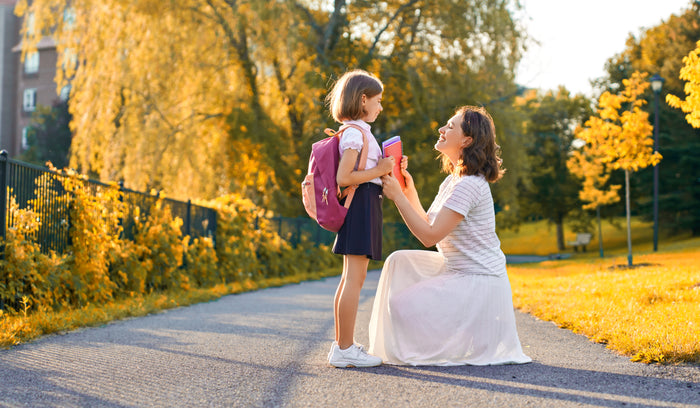When the Scariest Part of Parenthood Is Socializing With Other Parents | Parents Survival Guide

A planner by nature, I anticipated my babies’ arrivals by reading all the books, making all the lists, doing all the research, and generally convincing myself I had made a terrible mistake. Thankfully, both of my children survived their earliest years without much trouble, and I relaxed a little. However, just when it seemed like we were finally figuring things out, they started school.
At first, the great challenges of school included trusting the classroom educators, acclimating to a different routine, and remembering where to find things such as the online school calendar. But as the kids moved from their rural Maine Montessori years (from ages 3 to 5) to the Chicago Public Schools, things changed.
A lot.
Of course, the kids met our new challenges with resilience and grace, quickly falling into a new normal. I, on the other hand, have had a bumpier go of things.
You see, as an introvert, the scariest part of parenthood for me is socializing with other parents. Little by little, I’m figuring out ways to manage my discomfort, but I’m discovering there’s no quick or fast solution. Here are some of the challenges I’ve faced as an introverted parent, and what I’ve learned.
I am the kind of introverted working mother who can fake social ease just enough to keep the red flags lowered — as long as the socializing comes in short bursts, in small, familiar groups (one-on-one is ideal), and it’s extra helpful if I have a defined purpose for being there (i.e., if it’s my job). Alternatively, opened-ended and undefined social situations are, for me, the equivalent of the boogie man.
My kids are now six and seven. They are sweet, social people who enjoy playdates and group activities. They long to be in the mix of their school and neighborhood communities — after-school events, potlucks, and street parties. So I say yes to some things, and we keep showing up. We show up, the kids find their people and take off with their little wolf packs. I linger at the edge of the activity, not totally unlike a lone sock hanging limply from a clothesline.
Recently in therapy, I described my social-anxiety-while-among-other-parents as a middle school regression. It’s especially prevalent with other mothers. If faced with a large group of mothers who are catching up with each other in chatty clusters of designer leggings, sporty vests, and baseball caps, I immediately feel like I am 12 years old, standing at the front of the middle school cafeteria, feeling very Asian (which I am), wearing the wrong clothes, and wondering where to sit. To be honest, I skipped lunch for most of the middle school and high school and instead read peacefully in the library.
But it’s no longer just about me.
Before I continue, I have a few disclaimers. I always have disclaimers.
- I’m sure the other mothers/parents are fine. My own social obstacles are not a judgement on them.
- I am not looking for sympathy. This is simply how I am, and devising strategies for navigating this is my own inside job.
- I could avoid these situations, but my own introverted personality shouldn’t prevent my kids from participating in their communities.
- It’s important for my kids to see me doing things that I find hard and uncomfortable.
When I spoke to my therapist about this particular issue, she reminded me that many people struggle to find their place among other parents. On one hand, this is a good reminder that we all have our challenges — introverted or not — but dealing with it sometimes calls for very different game plans depending on the individual.
The other day, I read this article in The New York Times called “Making Friends With Other Parents Is Like Dating.” While I found it interesting, the tips didn’t resonate as much as I had hoped because I’m not trying to find my next BFF. The article touches upon the awkwardness and uncertainty among peer parents, but it encourages friend-making. I do enjoy my friends and occasionally developing new friendships, but my main goal is to feel at peace when required to share space with other parents.
It’s not easy being an introverted parent, but learning to look at things a little differently has helped me when I’ve found myself volunteering in my kids’ classrooms, at a mother-son dance, or at a school potluck. If you’re an introverted parent, I hope these three things help you, too:
This is easier than it sounds because unfortunately, I do care what people think of me. I’m not sure why this is, but whatever the reason, the best way forward, as author Anne Lamott reminds us, is bird by bird. And as Glennon Doyle reminds us, we just have to do the next hard thing.
So if my strongest instinct is to bring a book and read quietly while the kids are playing, I should read my book. Yes, it makes me fairly unapproachable and perhaps, to some, a little rude. But if I’m not causing harm, if I’m keeping an eye on my kids, and I don’t feel like practicing the small talk, then really, I should be able to read my book.
I am the mom who prefers to be with the kids. The kid space feels down-to-earth, authentic, and comfortable. I find myself, at times, in the center of a kid circle. My kids will come to tell me something, their friends will follow, and the next thing I know, we are in a discussion about their game, their classroom, or a funny joke someone just learned. Perhaps I am not intimidated by elementary school kids because they are usually the only ones who are shorter than I am. But it’s probably because they are the most fun.
As introverts, our minds are always going, imagining what might be coming up next. So this point is possibly the hardest one for me. However, if I don’t have any expectations for whatever I’m doing, I can relax a little. This is more of an overall life strategy, but it can work well with other parents. If I do not expect anyone to interact with me in any specific way, if I don’t expect to feel like a weirdo while doing my own thing, if I don’t expect any event to be great or terrible, it’s easier to find moments where I can be present.
Recently, I was sitting on a bench, listening to a podcast, watching my son play at the park. Another mom came up and sat next to me, commenting that sitting quietly seemed like a good idea. So that’s what we did — we sat peacefully together, without awkwardness or expectation, simply watching our kids play. Sometimes it’s enough just to show up.
So I will. I will show up when it’s important for my kids, and I will continue to challenge myself to find my place among other parents. Sometimes it will be scary, but sometimes it might be pretty good. Most often, I imagine, it will fall somewhere in the middle. And that in itself is a valuable message for my kids: In our family, we try hard, we do things that scare us, and even when the results are average at best, we should still feel okay about it.










































